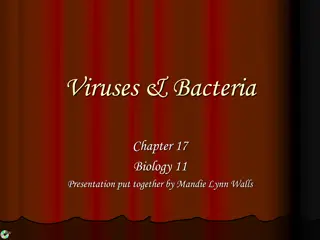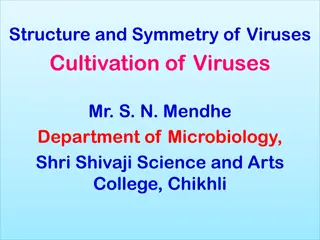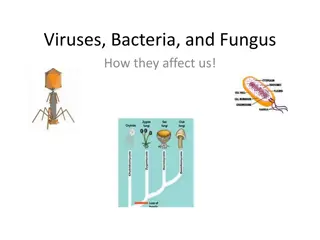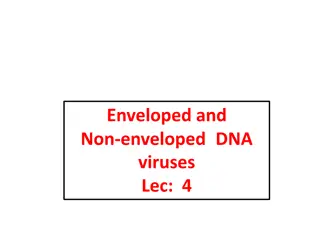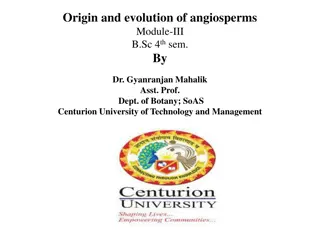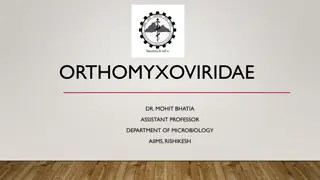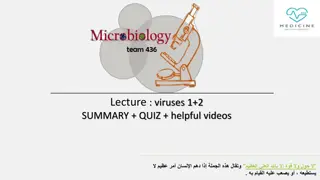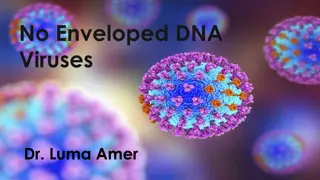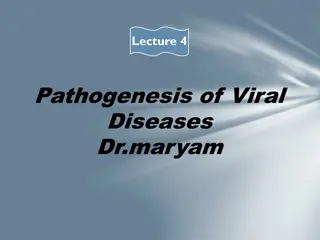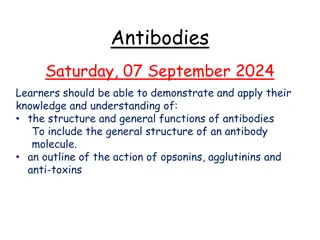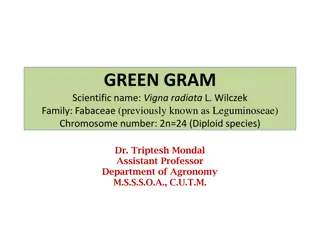Understanding Viruses: Origin, Structure, and Importance in Research
Viruses are microscopic organisms that rely on living cells to replicate and cause a range of illnesses in humans, animals, and plants. Studying viruses has led to significant scientific breakthroughs, providing insights into essential biological mechanisms and disease processes. Theories on the origin of viruses include regressive evolution, cellular origins, and independent entities. Understanding the structure of viruses, which consist of a nucleic acid genome, is crucial for developing strategies to combat viral infections.
Download Presentation

Please find below an Image/Link to download the presentation.
The content on the website is provided AS IS for your information and personal use only. It may not be sold, licensed, or shared on other websites without obtaining consent from the author. Download presentation by click this link. If you encounter any issues during the download, it is possible that the publisher has removed the file from their server.
E N D
Presentation Transcript
What is the virus A microorganism that is smaller than a bacterium that cannot grow or reproduce apart from a living cell. A virus invades living cells and uses their chemical machinery to keep itself alive and to replicate itself. It may reproduce with fidelity or with errors (mutations); this ability to mutate is responsible for the ability of some viruses to change slightly in each infected person, making treatment difficult. Viruses cause many common human infections and are also responsible for a number of rare diseases. Examples of viral illnesses range from the common cold, which can be caused by one of the rhinoviruses, to AIDS, which is caused by HIV. They can vary greatly in size, from approximately 5-10 kb (Papovaviridae, Parvoviridae, etc.) to greater than 100-200 kb (Herpesviridae, Poxviridae).
Why Study Viruses? A) Viruses are the cause of many diseases of animals, humans and plants. B) Viruses are simple genetic systems that allow us to study basic biochemical mechanisms such as replication, transcription, mutation, etc. Some important scientific advances that were made using viruses were: the discovery of RNA splicing, the development of the first in vitro DNA replication system, the first complete genome sequenced, etc.
C) Because they are obligate intracellular parasites, viruses use the host cell machinery to express their genes and replicate their genomes. They therefore tell us a great deal about the biochemistry and cell biology of mammalian cells. In many cases, viruses also disrupt important cellular processes, and therefore give insight into what happens when cell regulation is disrupted ( development of cancer, immune deficiencies, etc.). D) Viruses are fascinating in their own right because they have evolved very unique, interesting and varied life cycles.
Theories on Origin of viruses: 1. Regressive evolution: This theory states that viruses are degenerate life forms that have lost many functions that other organisms possess and have only retained the genetic information essential to their parasitic way of life. 2. Cellular origins: In this theory, viruses are thought to be subcellular, functional assemblies of macromolecules that have escaped their origins inside cells. 3. Independent entities: This theory suggests that viruses evolved on a parallel course to cellular organisms from the self-replicating molecules believed to have existed in the primitive, prebiotic RNA world. This is similar to what spontaneous generation stated that viruses created from primitive cellular molecules have replication properties such as plasmids.
Structure of the viruses All viruses contain the following two components: 1) a nucleic acid genome Viruses may contain either DNA or RNA as their genetic material. Herpes simplex virus and the hepatitis B virus are DNA viruses. RNA viruses have an enzyme called reverse transcriptase that permits the usual sequence of DNA-to-RNA to be reversed so that the virus can make a DNA version of itself. The known structures of viral genomes are summarized below as David Baltimore proposed that viruses be classified according to the nature of their genome to:-
DNA: Double Stranded - linear or circular Single Stranded - linear or circular RNA: Double Stranded - linear or circular Single Stranded - linear : These single stranded genomes can be either + sense, - sense, the sense strand is the one that can serve directly as mRNA and code for protein, so for these viruses, the viral RNA is infectious. The viral mRNA from - strand viruses is not infectious, since it needs to be copied into the + strand before it can be translated. The genome of some RNA viruses is segmented, meaning that a virus particle contains several different molecules of RNA, like different chromosomes.
2 protein capsid that covers the genome. Together this is called the nucleocapsid. Viral genomes are surrounded by protein shells known as capsids. One interesting question is how capsid proteins recognize viral, but not cellular RNA or DNA. The answer is that there is often some type of "packaging" signal (sequence) on the viral genome that is recognized by the capsid proteins. A capsid is almost always made up of repeating structural subunits that are arranged in one of two symmetrical structures, a helix or an icosahedron. In the simplest case, these "subunits" consist of a single polypeptide. In many cases, however, these structural subunits (also called protomers) are made up of several polypeptides. Both helical and icosahedral structures are described in more detail below.
a)Helical Capsids:The first and best studied example is the plant tobacco mosaic virus (TMV), which contains a SS RNA genome and a protein coat made up of a single, 17.5 kd protein. This protein is arranged in a helix around the viral RNA. Helical capsids can also be more complex, and involve more than one protein subunit. https://upload.wikimedia.org/wikipedia/commons/thumb/9/95/Helical_capsid_with_RNA.png/220px-Helical_capsid_with_RNA.png
Several families of animal virus contain helical nucleocapsids, including the Orthomyxoviridae (influenza), the Paramyxoviridae (bovine respiratory syncytial virus), and the Rhabdoviridae (rabies). All of these are enveloped viruses.
a)Icosahedral Capsids:In these structures, the subunits are arranged in the form of a hollow, semi spherical structure, with the genome within. An icosahedron is defined as being made up of 20 equilateral triangular faces arranged around the surface of a sphere. https://upload.wikimedia.org/wikipedia/commons/thumb/6/6a/Adenovirus_3D_schematic.png/220px-Adenovirus_3D_schematic.png
C) Complex These viruses possess a capsid that is neither purely helical nor purely icosahedral, and that may possess extra structures such as protein tails or a complex outer wall. Some bacteriophages, such as Enterobacteria phage T4, have a complex structure consisting of an icosahedral head bound to a helical tail. This tail structure acts like a molecular syringe, attaching to the bacterial host and then injecting the viral genome into the cell.
In addition, many animal viruses contain a 3) lipid envelope The entire intact virus is called the virion. The structure and composition of these components can vary widely. In some animal viruses, the nucleocapsid is surrounded by a membrane, also called an envelope. This envelope is made up of a lipid bilayer, and is comprised of host-cell lipids. It also contains virally encoded proteins, often glycoproteins which are trans-membrane proteins. These viral proteins serve many purposes, such as binding to receptors on the host cell, playing a role in membrane fusion and cell entry, etc. They can also form channels in the viral membrane.
Many enveloped viruses also contain matrix proteins, which are internal proteins that link the nucleocapsid to the envelope. They are very abundant (ie, many copies per virion). Some virions also contain other, non-structural proteins that are used in the viral life cycle. Examples of this are replicases, transcription factors, etc. These non-structural proteins are present in low amounts in the virion. Enveloped viruses are formed by budding through cellular membranes, usually the plasma membrane but sometimes an internal membrane such as the ER, golgi, or nucleus. In these cases, the assembly of viral components (genome, capsid, matrix) occurs on the inside face of the membrane, the envelope glycoproteins cluster in that region of the membrane, and the virus buds out. This ability to bud allows the virus to exit the host cell without lysing, or killing the host. In contrast, non-enveloped viruses, and some enveloped viruses, kill the host cell in order to escape.
Virus Classification/Nomenclature To understand the features shared among different groups of viruses, a classification scheme is necessary. However, most viruses are not thought to have evolved from a common ancestor, so the methods that scientists use to classify living things are not very useful. Biologists have used several classification systems in the past, based on the morphology and genetics of the different viruses. However, these earlier classification methods grouped viruses based on which features of the virus they were using to classify them. The most commonly-used classification method today is called the Baltimore classification scheme which is based on how messenger RNA (mRNA) is generated in each particular type of virus. The surface structure of virions can be observed by both scanning and transmission electron microscopy, whereas the internal structures of the virus can only be observed in images from a transmission electron microscope.
Classified the virus according to :- 1- Baltimore classification Group I Characterstics Double- stranded DNA Mode of RNA production mRNA is transcribed directly from the DNA template Example Herpes simplex(herpes virus) Parvovirus II Single-stranded DNA DNA is converted to double stranded form before RNA is transcribed III Double- stranded RNA mRNA is transcribed from the RNA genome Childhood gastroenteritis (rotavirus) Common cold (Picornavirus) IV Single- stranded RNA(+) Genome function as mRNA V Single- stranded RNA(-) mRNA is transcribed from the RNA genome Rabies(Rhabdoviru s) VI Single -stranded RNA with reverse transcriptase Reverse transcriptase makes DNA from the RNA genome, DNA is then incorporated with host genome, mRNA is transcribed from the incorporated DNA The viral genome is double stranded DNA but viral DNA is replicate through an RNA intermediate, the RNA may serve directly as mRNA or as a template to make mRNA Human Immunodeficiency virus(HIV) VII Double- stranded DNA with reverse transcriptase Hepatitis B virus (Hepadnavirus)
2-Capsid structure Virus classification by capsid structure Capsid classification Naked icosahedral Enveloped icosahedral Examples Hepatitis A, Poliovirus Epstein Bar Virus, Simplex Virus, Rubella Virus, HIV Influenza Virus, Mumps, Measles Virus, Rabies virus Tobacco Mosaic Virus Herpesvirus, smallpox virus, T4 bacteriophage Enveloped helical Naked helical Complex with many proteins, some have combinations of icosahedral and helical capsid structures
Using these and other criteria, the International Committee on Nomenclature of Viruses (ICTV) produced the following the hierarchical system for viral classification. 1) Orders (virales): Groupings of families of viruses that share common characteristics and are distinct from other orders and families. 2) Families (-viridae): Groupings of genera of viruses that share common characteristics and are distinct from the member viruses of other families. 3) Subfamilies (-virinae): Not used in all families, but allows for more complex hierarchy of taxa.
4) Genera (-virus): Groupings of species of viruses that share common characteristics and are distinct from the member viruses of other species. 5) Species (virus): The definition accepted by ICTV is "a virus species is defined as a polythetic class of viruses that constitutes a replicating lineage and occupies a particular ecological niche". A species can be further broken down into strains, variants, subspecies which desighnated by numbers, etc.
Order: Mononegavirales Family: Paramyxoviridae Genus: Rubulavirus Species: Mumps virus Human Parainfluenza virus 2 Human Parainfluenza virus 4



